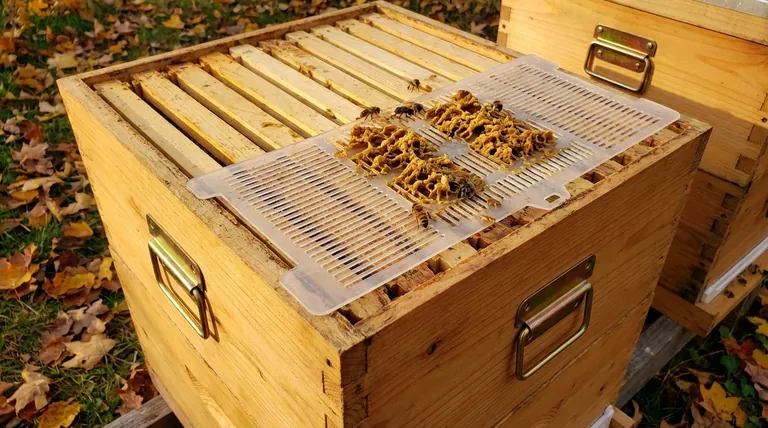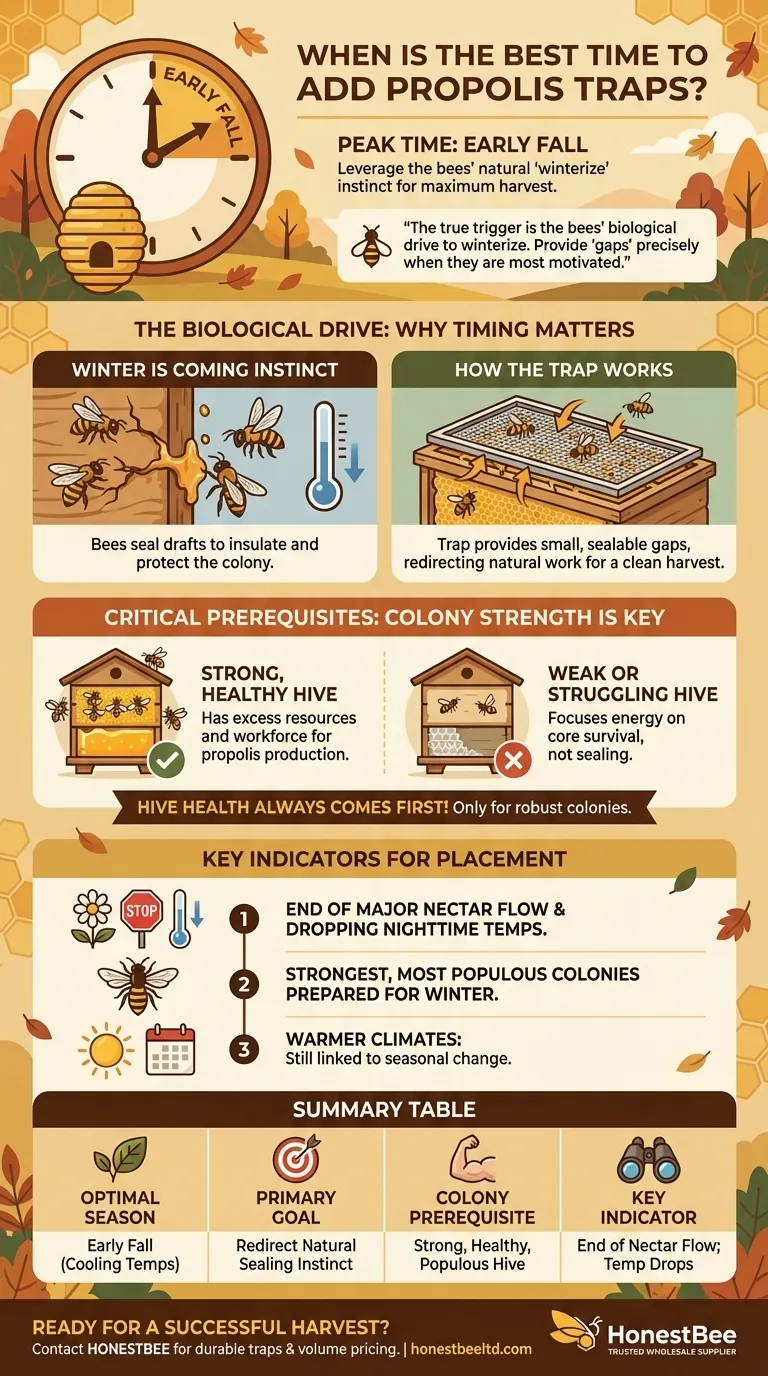For a maximum propolis harvest, the ideal time to add your traps is during early fall. This timing capitalizes on the bees' powerful natural instinct to find and seal every crack and gap in their hive in preparation for the colder months ahead.
While early fall is the prime season for propolis production, the true trigger is the bees' biological drive to winterize. Your goal as a beekeeper is to provide them with "gaps" to fill precisely when they are most motivated to do so.

Why Timing is Everything for Propolis Collection
Understanding the bees' motivation is key to a successful harvest. Propolis production isn't a constant activity; it's a behavior driven by specific environmental cues and colony needs.
The "Winter is Coming" Instinct
As days shorten and temperatures begin to drop in early fall, the honey bee colony's priorities shift. Their focus moves from foraging and brood-rearing to preparing the hive for winter survival.
A major part of this preparation involves using propolis, a resinous mixture collected from tree buds, to seal any drafts. This natural "caulking" insulates the hive, conserves heat, and protects the cluster from harsh weather.
How a Propolis Trap Works
A propolis trap is essentially a screen or mat with small gaps that you place at the top of the hive. These gaps are too small for a bee to pass through but large enough that they trigger the instinct to seal them.
By adding the trap when the bees are already in a sealing mindset, you are simply redirecting their natural work into a device that allows for a clean and efficient harvest.
Colony Strength is a Prerequisite
Propolis collection is a task for a strong, healthy, and populous colony. A hive that is struggling with pests, disease, or low population numbers will not have the surplus workforce or resources to produce excess propolis.
Their energy will be focused on core survival tasks, not on meticulously sealing non-critical gaps in a trap.
Understanding the Trade-offs and Considerations
While propolis collection is a valuable secondary harvest, it should never come at the expense of colony health.
Hive Health Always Comes First
Before adding a trap, perform a thorough hive inspection. Ensure the colony is strong, has a good population, and has adequate food stores for winter. Placing a trap on a weak hive is counterproductive.
Observe Regional and Genetic Variations
The exact timing for "early fall" varies by climate. More importantly, propolis production is highly dependent on other factors.
The availability of resin-producing trees and the genetic predisposition of your honey bees play a significant role. Some strains of bees are known to produce far more propolis than others.
Frequency of Harvest
While the trap is best placed in the fall, harvesting frequency can vary. Some beekeepers may get a full harvest in four to six weeks, while others leave the trap on all winter for a single large harvest in the spring. This depends on hive strength and local conditions.
Key Indicators for Placing Your Traps
Timing is less about a specific calendar date and more about observing your hive and its environment. Look for these signals.
- If your primary focus is maximizing the harvest: Place the trap on the hive as the last major nectar flow of the season ends and nighttime temperatures begin to drop.
- If your primary focus is hive health: Only add a propolis trap to your strongest and most populous colonies that are already well-prepared for winter.
- If you are in a warmer climate: You may have a longer window for propolis collection, but the peak impulse will still be tied to the changing of the seasons.
By aligning your efforts with the bees' natural calendar, you ensure a successful harvest while supporting the overall health of the colony.
Summary Table:
| Key Factor | Best Practice for Propolis Traps |
|---|---|
| Optimal Season | Early Fall (triggered by cooling temperatures) |
| Primary Goal | Redirect the bees' natural instinct to seal gaps for winter |
| Colony Prerequisite | Strong, healthy, and populous hive |
| Key Indicator | End of the last major nectar flow; dropping nighttime temperatures |
Ready to equip your apiary for a successful propolis harvest?
As a trusted wholesale supplier for commercial apiaries and distributors, HONESTBEE provides the durable, high-quality propolis traps and beekeeping equipment your operation needs. Our wholesale-focused model ensures you get reliable gear at competitive prices, helping you maximize secondary revenue streams like propolis without compromising hive health.
Contact our team today to discuss your equipment needs and volume pricing.
Visual Guide

Related Products
- Professional Drop-Style Hive Handles for Beekeeping
- Reusable Clear Small Hive Beetle Traps for Beehives Beetle Trapping Tools
- Black Plastic Beetle Barn Hive Beetle Trap for Beehives
- Reusable Aluminium Beetle Trap for Small Hive Beetles Silver Bullet
- Endless Loop Ratchet Hive Strap
People Also Ask
- What is the role of gloves in beekeeping, especially for beginners? Build Confidence & Safety
- Why are hive tools painted in bright colors? Prevent Losing Your Essential Beekeeping Gear
- What are the characteristics of the bristles on a bee brush? Designed for Gentle Persuasion, Not Force
- What types of gloves are available for beekeeping? Choose the Right Protection for Your Hive
- What makes polyurethane foam environmentally friendly? The Surprising Benefits of a Durable, Inert Material



















